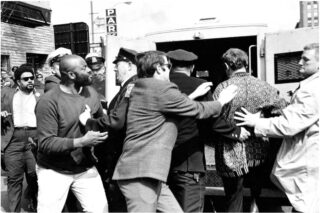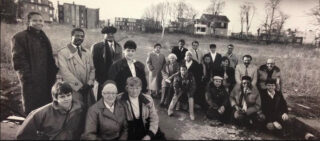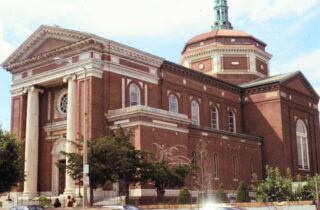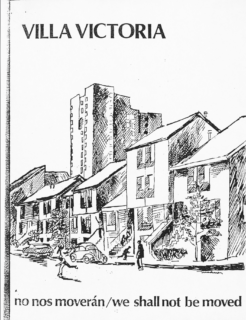

Boston Police arrested demonstrators, including Mel King (left), director of the Urban League, during a protest advocating the construction of low-rent housing on vacant lots, at the Fitz-Inn parking lot on Dartmouth Street in Boston’s South End on April 26, 1968. Ollie Noonan Jr./Globe Staff.
Written by Katherine Faulkner.
Connecting with a state-wide reading initiative, I recently joined a book group to discuss Mel King’s Chain of Change: Struggles for Black Community Development. Melvin ‘Mel’ King (1928-2023) is a well-known Bostonian with a powerful legacy as an active organizer, educator, and politician in the city for more than 50 years. My vague familiarity with Mr. King has been around his work with Boston Public Schools, where he was central to exposing the baked-in unfairness and inequality among the racially divided neighborhoods. He led the 1968 protest at Tent City in the South End; he ran for Mayor against Ray Flynn in 1983. In 2011, when competing for Boston Development Parcel 9, I was directly instructed by Mel King to respect the core tenets of the Lower Roxbury Strategic Master Plan and the essence of community engagement. The book is considered a field guide for building coalition. To be honest, feeling hammered by current events, I am looking for guidance.


1985. Residents of Dudley Street neighborhood unite to revitalize their community. Photo: Holding Ground Productions.
Mel King’s is not my story to tell. In the decades between 1952 and 1981, when the book was published, cities across the country were confronting urban renewal, white-flight, and the Civil Rights Movement. In 1971, when Mr. King was fighting for fair hiring and better housing, my family left Boston for a well-endowed suburb. In 1976, when Ted Landsmark was attacked outside of City Hall, I was a self-absorbed pre-teen worrying about my braces and my hair. Chain of Change is full of familiar names like Melnea Cass, Ruth Batson, Chuck Turner, Byron Rushing, and John O’Bryant, with reference to the important work they did (and is some cases still do) for the black and broader urban communities. Mr. King recounts structural transformations of the school committee, City Council, unions, and the Boston Redevelopment Authority. He had a long and influential run. As I regularly cross the corner of Dartmouth and Columbus Avenue without a thought for the people living in tents over 3 chilly days in April ’68 – protesting former BRA director Ed Logue’s plan to develop a luxury high-rise – it is apparent that simply shaking one’s head over government actions is implicit acceptance. Protest requires concrete action and persistence.


After 20 years of standing empty, the Blessed Sacrament Church will be preserved and adapted into housing by Pennrose Development. Photo Historic Boston Inc.
Our small reading group is loosely connected around a Jamaica Plain church, with long-time residents and activists for gay-marriage, social justice, and the environment. Several in the group are retired from careers with community development corporations. One participant worked with the Dudley Square Neighborhood Initiative (DSNI), the first neighborhood group in the country to be granted eminent domain over abandoned property (see Holding Ground). When the conversation turned to housing, it was assumed that I could contribute in a meaningful way. “Who is our Mel King? Why is housing so expensive? How can we help?” Like aging oracles, the other community developers and I exchanged knowing glances. We described the web of tax credits, the MBTA Communities Act, the Housing Bond Bill, and other pillars of the Affordable Homes Act. “It’s complicated,” I assured the others, as if I had the situation well in hand, which, of course, I do not.
At its core, the lack of affordable housing is not that complicated. Construction is expensive, building and zoning codes can add significant time to the approvals process, and demand is greater than the supply. When Governor Healy promises 255,000 units to be constructed in the next 10 years, neither she nor the State is actually building them. They are offering carrots and sticks to developers and communities in the form of loans and rebates. A small or inexperienced developer may find housing funds difficult to access; the incentives seem tilted toward large developers and big loaf buildings, the stuff of American the Bland. At the micro-scale, accessory dwelling units (ADUs) are officially allowed statewide, which means an apartment of less than 900 square feet can be built as an addition or free-standing structure on an existing single-family lot, whether or not your town or city allows them. Some municipalities, notably Cambridge, have eliminated single-family zoning altogether. Realistically, these changes may yield a few thousand apartments in the coming decade, but they are indicative of changing minds. Likely, the balance of the units will come from new construction. With the Governor’s promise, it is important to remember that 255,000 is a goal but not an end. Large-scale housing developments do not generally yield neighborhoods. Getting to 255,000 also means making a positive contribution to the community, with places to walk, garden, ride bikes, navigate strollers and wheelchairs. Children can go to school, adults can go to work, and seniors can age in place or live in service-supported developments.


A poster promoting Villa Victoria in Boston, a nonprofit housing development organized by Inquilinos Boricuas en Acción, formerly the Emergency Tenants Council. Image courtesy Northeastern University Archives and Special Collections
Near the end of the book, Mel King summarizes lessons learned from his activism around housing; from early efforts to adequately shelter black families to ultimately designing, packaging, and financing developments built on “human need and the concept of community.” He references Inquilinos Boricuas en Accion’s (IBA) 1976 development of Villa Victoria in Boston’s South End. After protracted protests and negotiations with the BRA to protest the displacement of about 2000 Puerto Rican residents, IBA won the right to redevelop their neighborhood into 435 permanently affordable units, with a culture complex and community assets that are still vibrant today. Mr. King’s Vision for Our City, stresses sharing, compassion, creativity, and respect as central ingredients to community success. While there is no question that we need more housing, building apartment buildings as fast and as big as possible will not likely yield vibrant growth for cities and towns. Meeting housing goals need not require the sacrifice of pride of place. We have to try a little harder.